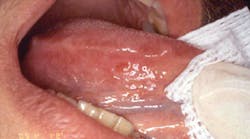Dental associations urge regular oral cancer examinations for early detection
RELATED |A necessary challenge: How to talk to your patients about the connection between HPV and oral cancer As the nation observes the 14th Annual Oral Cancer Awareness Month this month, the American Academy of Oral & Maxillofacial Pathology, American Academy of Periodontology, the American Association of Oral and Maxillofacial Surgeons, and the American Dental Association have joined the Oral Cancer Foundation in its campaign to remind everyone that regular oral cancer examinations from your dental professional are the best methods to detect oral cancer in its early stages. Regular dental visits can improve the chances that any suspicious changes in your oral health will be caught early, at a time when cancer can be treated more easily.RELATED | Oral cancer is on the rise: Consumer Reports falls short
In between dental visits, it is important for patients to be aware of the following signs and symptoms, and to see their dentist if they do not disappear after two weeks. • A sore or irritation that doesn’t go away • Red or white patches • Pain, tenderness or numbness in mouth or lips • A lump, thickening, rough spot, crust or small eroded area • Difficulty chewing, swallowing, speaking, or moving your jaw or tongue • A change in the way your teeth fit together when you close your mouthRELATED | Oral Cancer Foundation sponsors 14th Annual Oral Cancer Awareness Month in April 2013Factors that may cause cancer
Research has identified a number of factors that may contribute to the development of oral cancer. Those at an especially high risk of developing oral cancer are heavy drinkers and smokers older than 50. The human papillomavirus version 16, which is sexually transmitted, is related to the increasing incidence of mouth cancer in nonsmoking patients. It is likely that there is a complex interaction of many external and internal factors that play a role in the development of oral cancer. Your mouth is one of your body's most important early warning systems. Don't ignore any suspicious lumps or sores that last more than two weeks. Should you discover something suspicious, make an appointment for a prompt examination. Early treatment may well be the key to complete recovery. For more information about oral cancer, its diagnosis and treatment, visit the Oral Cancer Foundation’s website. The American Academy of Oral and Maxillofacial Pathology (AAOMP) represents the dental specialty that identifies and manages diseases affecting the oral and maxillofacial regions and investigates the causes, processes, and effects of these diseases. Our clinical practitioners, researchers, educators, and microscopic diagnosticians collaborate with other dental and medical professionals to advance oral health care. Oral and maxillofacial pathologists (OMP) are uniquely trained to efficiently address both diagnosis and treatment of oral disease, rapidly and reliably establish the critical connection between oral disease and systemic disease, and combine expertise in histopathologic diagnosis, clinical diagnosis, and treatment. For more information, visit the American Academy of Oral and Maxillofacial Pathologists' website. The American Academy of Periodontology (AAP) is the professional organization for periodontists – specialists in the prevention, diagnosis, and treatment of diseases affecting the gums and supporting structures of the teeth, and in the placement of dental implants. Periodontists are also dentistry’s experts in the treatment of oral inflammation. They receive three additional years of specialized training following dental school, and periodontics is one of the nine dental specialties recognized by the American Dental Association. The AAP has 8,300 members world-wide. For more information visit the American Academy of Periodontology website. Saving Faces, Changing Lives® — The American Association of Oral and Maxillofacial Surgeons (AAOMS), the professional organization representing more than 9,500 oral and maxillofacial surgeons in the United States, supports its fellows’ and members’ ability to practice their specialty through education, research and advocacy. AAOMS fellows and members comply with rigorous continuing education requirements and submit to periodic office anesthesia evaluations, ensuring the public that all office procedures and personnel meet stringent national standards. For more information visit the American Association of Oral and Maxillofacial Surgeons website. The not-for-profit American Dental Association is the nation's largest dental association, representing 157,000 dentist members. The premier source of oral health information, the ADA has advocated for the public's health and promoted the art and science of dentistry since 1859. The ADA's state-of-the-art research facilities develop and test dental products and materials that have advanced the practice of dentistry and made the patient experience more positive. The ADA Seal of Acceptance long has been a valuable and respected guide to consumer dental care products. The monthly Journal of the American Dental Association (JADA) is the ADA's flagship publication and the best-read scientific journal in dentistry. For more information about the ADA, visit www.ada.org. For more information on oral health, including prevention, care and treatment of dental disease, visit the ADA’s consumer website. The Oral Cancer Foundation, founded by oral cancer survivor Brian R. Hill, is a nonprofit 501(c)(3) public service charity that provides information, patient support, sponsorship of research, and advocacy related to this disease. Oral cancer is the largest group of those cancers that fall into the head and neck cancer category. Common names for it include such things as mouth cancer, tongue cancer, head and neck cancer, and throat cancer. It maintains a website at http://www.oralcancer.org, which receives millions of hits per month. Supporting the foundation's goals is a scientific advisory board composed of leading cancer authorities from varied medical and dental specialties, and from prominent educational, treatment, and research institutions in the United States. For more information visit the Oral Cancer Foundation website.







